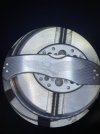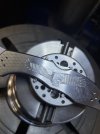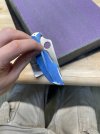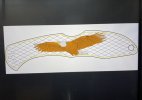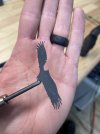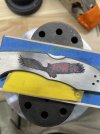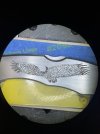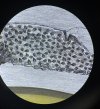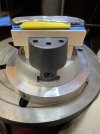I’m working on my first multi color inlay. Copper, 24k gold, and fine silver. I plan to do the copper as a 20 gauge sheet inlay and the gold/silver with 24 gauge dead soft wire.
I started by sanding the stainless steel spyderco delica against my surface plate with 120, 400 and 600 grit to get it dead flat. I use a trick I’m sure some of you know to maker it easier to hold the piece while sanding. You can fold painters tape to make a small handle for yourself as shown in the photos.
Im working on removing the material before undercutting the edges and raising a field of burrs to hold the copper in place.
I plan next to do the fine silver inlay near the head and tail feathers. Not a lot of difference in color between the .999 silver and stainless steel but I like the challenge/learning experience. Also the silver seems to be a bit more white vs silver of the stainless.
Any critiques welcomes, I’ll post more on this thread as I move along.
I started by sanding the stainless steel spyderco delica against my surface plate with 120, 400 and 600 grit to get it dead flat. I use a trick I’m sure some of you know to maker it easier to hold the piece while sanding. You can fold painters tape to make a small handle for yourself as shown in the photos.
Im working on removing the material before undercutting the edges and raising a field of burrs to hold the copper in place.
I plan next to do the fine silver inlay near the head and tail feathers. Not a lot of difference in color between the .999 silver and stainless steel but I like the challenge/learning experience. Also the silver seems to be a bit more white vs silver of the stainless.
Any critiques welcomes, I’ll post more on this thread as I move along.


